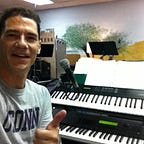Brad Carlin — The Doobie Brothers Podcast
Anyone who listened to American radio in the 1970’s probably recognizes the familiar sound of The Doobie Brothers, with its jangly rhythmic guitars and tight vocal harmonies. Hailing from San Jose, California, the Doobies originally consisted of Tommy Johnston and Patrick Simmons on guitars and vocals, Dave Shogren on bass, and John Hartman on drums. After spending much of 1970 honing their sound in northern California biker bars and outdoor venues, they cut a demo album on a small local label that landed them a Warner Brothers recording contract. “Quicksilver Princess” and other tracks from that demo already revealed much of what was to become the band’s familiar R&B-influenced rock and roll sound.
The band’s first Warner release oddly emphasized acoustic guitars and more country influences, and failed to chart. However, after adding a second drummer and returning to their original somewhat harder sound, they released a string of successful albums in the early 1970s. These albums produced such hits as “Listen to the Music”, “Long Train Running”, “China Grove”, and “Eyes of Silver”. Most of the band’s hits featured Johnston’s electric guitar and lead vocal, but somewhat surprisingly, the band’s first #1 hit was actually the Simmon’s acoustic number, “Black Water”.
The rigors of touring and producing an album per year took their toll on Johnston’s health, forcing him to leave the band in 1976. His replacement was Michael McDonald, whose keyboards and husky baritone had been featured on a variety of Steely Dan hits. McDonald steered the band towards more musically complex, syncopated blue-eyed soul material, taking the band in an entirely new but still commercially viable direction. The success of the McDonald track “Takin it to the Streets” foreshadowed the band’s greatest commercial success. This was, of course, its 1978 release of “What a Fool Believes”, the band’s second #1 single. This track also won a Grammy for song of the year, an honor for which the album’s title track, “Minute by Minute”, was also nominated.
Sadly, creative differences and road burnout caused the band’s star to fade quickly in the early 1980s, with the apparent end coming in 1982. However, a limited 1987 reunion tour caused Johnston, Simmons, and other original members to realize that re-forming was an option. This version of the band released two albums for Capital Records in 1989 and 1991. The second of these albums included the track “Dangerous”, a Simmons composition that left no doubt as to the band’s return to its original early 70s sound.
The Doobie Brothers continue to record new material and tour, playing about 70–80 shows each year. While both Johnston and Simmons just turned 70 last year, it seems likely the guitar licks and vocal harmonies will continue to ring out for several more years to come.
